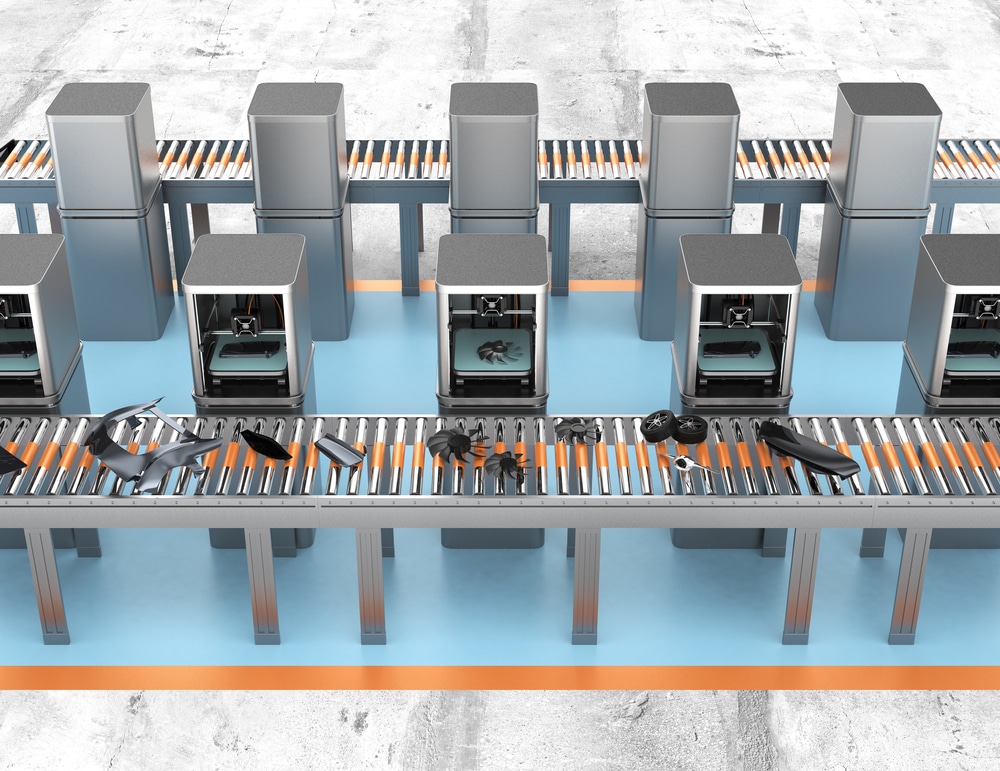Today’s factories are becoming smarter and more connected. With greater automation in smart factories, manufacturers can lower costs, and achieve higher throughput and yield. As a highly flexible and automated manufacturing process, 3D printing technology is elevating connected manufacturing and smart factories.
3D printing is allowing companies to improve manufacturing capabilities, whether in-house or leveraging contract 3D printing services in a smart factory. Companies in many industries can see multiple benefits when they use 3D printing smart factories for high volume or low volume/high mix manufacturing. Here’s how companies can accelerate the go-to-market of new products from prototyping to high volume manufacturing.

Accelerating From Design or Prototyping through High Volume Manufacturing with 3D Printing
In traditional manufacturing, it is a long process to prepare new products for high volume manufacturing. Making the transition to high volume manufacturing can be difficult as processes and materials for prototyping can be different than the ones for mass-production. Connected manufacturing and automation have helped bring down costs and increase efficiency in high volume manufacturing operations. However, high mix/low volume manufacturers find it more difficult to enable similar automation and efficiency.
When making the transition from design to high volume production, companies face the following challenges:
- Slow to scale. Scaling with traditional processes takes months of prototyping, redesigns, and tooling. Prototypes need to be carefully designed to conform to the manufacturing process and tooling needs to be fabricated. Both of these steps incur extra time and costs when scaling.
- Limited design complexity. Traditional manufacturing processes like injection molding and CNC milling limit the complexity of many products. More complex products require more tooling, assembly steps, and raw materials, all of which increase time and cost.
- No agility – locked into a product and process. If the market for product changes, it is difficult to pivot without major re-tooling or modification to the manufacturing process. The lack of agility with traditional processes creates excessive risk for low volume manufacturers.
3D printing addresses these pain points because it does not require retooling, enables manufacturing agility, and allows greater design complexity. Simplifying manufacturing for prototyping and production, 3D printing provides a faster way to scale.
Traditional processes are slow to scale and respond to market changes. Manufacturers who want to be agile need an alternative process. 3D printing provides an easier way to create prototypes, including for complex products, quickly scale up production, and augment existing manufacturing capacity.
Accessing Connected Manufacturing and Automation Via the Cloud
With traditional manufacturing, companies spend many cycles redesigning the prototype, running small batches, and adapting the design to production processes. Often prototyping and production use different materials, making it even more challenging scaling manufacturing with traditional processes.
Partnering with 3D printing smart factories, companies can take advantage of the connected manufacturing and automation typically associated with high volume production with traditional processes. Access to 3D printers in a smart factory lets companies use the same systems and processes for prototyping and full-scale production, giving low and high volume manufacturers key benefits:
- Get to market faster. A manufacturer can simply send their product design and order to a smart factory, and it will start production on a 3D printing line. It eliminates the time involved to scale with traditional processes like injection molding. The 3D printing order can consist of a high volume of a single product or low volume/high mix products.
- Print a mix of products. With the elimination of tooling, 3D printing systems can cost-effectively produce a high mix of similar products with the same process and system – at scale or on-demand.
- Respond to market changes quickly. 3D printing enables greater agility. Companies can easily adjust their design in prototyping or production and continue manufacturing. Additive manufacturing provides the freedom to switch to a new variation of the product and start printing at a smart factory.

When 3D printing services connect machines to a smart factory through the cloud, companies will have access to an on-demand 3D printing service as an extension of the business. Companies can instantly send a mix of products into production, respond to market changes, or augment manufacturing capacity—quickly scaling to larger or smaller production runs as needed.
When looking for on-demand scalability, more flexible high volume manufacturing, or greater automation with connected 3D printing systems in smart factories, see how LuxCreo provides a more agile and easy way to scale to high volume production. 3D print new prototypes in-house or instantly send approved designs to a local or overseas smart factory for high volume production. Use the same machine for prototyping and production, while reducing risk, cost, and cycle times.
To learn more about our processes and services for 3D printing at scale, visit our contact page or call (650) 336-0888.